Posted by Elena del Valle on January 27, 2010

Angela M. Kelley, vice president, Center for American Progress
Photo: Center for American Progress
While everyone is talking about unemployment and the recession who is paying attention to the increasing costs of maintaining our borders safe? Miles and miles of fence and even a portion of wall mar the United States Mexico line. Taxpayers are footing the ever growing bill that has jumped from $326 million in 1992 to $2.7 billion last year (The Economist, January 20, 2010).
At the same time, recent data indicates the cost of catching illegal immigrants is on the rise. In 2008, the border patrol made more than 791,000 arrests. Each one cost a little more than $3,000. Some question the efficacy of these efforts since illegal immigration tripled in those 17 years. In part, they believe, it is because many immigrants arrive into the country legally with tourist visas and remain illegally.
Looking inward, the question remains of how to deal fairly with the 12 to 15 million undocumented immigrants that are now in the country. Deporting 12 million illegal immigrants would require a convoy of more than 200,000 buses over more than 1,800 miles and that mass deportation would cost nearly $300 billion over five years, according to Principles for Immigration Reform Guidelines for Fixing Our Broken Immigration System, a report of the Center for American Progress (CAP) written by Marshall Fitz and Angela Maria Kelley and published December 2009. The Center for American Progress is a Washington, D.C. based think tank dedicated to “improving the lives of Americans through ideas and action.”
Some believe legalizing the status of the millions of undocumented residents would boost the economy over the long term. Raúl Hinojosa-Ojeda, Ph.D., founding director of the North American Integration and Development Center at the University of California, Los Angeles conducted research that leads him to believe that legalization of unauthorized workers would yield $1.5 trillion to the U.S. gross domestic product in 10 years. In three years it may generate $4.5 to $5.4 billion in tax revenue and consumer spending to support 750,000 to 900,000 jobs. In these days of economic contraction, unemployment and outsourcing, shouldn’t the powers that be listen to credible people promoting ways to generate jobs and additional GDP while saving millions in deportation costs?
“These are stark and significant numbers that lawmakers should commit to memory,” said Kelley, vice president for Immigration Policy and Advocacy at the Center for American Progress. “We have got an issue where we know we can improve the economy. It would be to their peril for lawmakers to be short sighted and not pass comprehensive immigration reform legislation that will reverberate and rev up the economy and help all Americans.”
According to Dr. Hinojosa’s research, a comprehensive immigration reform plan that legalizes the status of unauthorized workers and establishes a flexible visa program could result in higher wages for all workers in the country; while deporting the workers could cost $2.5 trillion over 10 years. That would be in addition to the costs of deportation of at least 12 million people.
Posted by Elena del Valle on January 26, 2010
Information provided by our Event Partner

Oct. 27-29, 2010, Miami, Florida
Discover New Growth Opportunities within the Multicultural Markets
The 7th Annual Multicultural Marketing Summit will showcase solutions from Fortune 1000 companies that are successfully targeting multicultural audiences. The Summit is hosted by Geoscape and will take place October 27-29, 2010 at the Epic Hotel in Miami, Florida.
The Summit is a standout, five-star event, highly rated by participants for the quality of its agenda and speakers. The chic ambiance of the Epic Hotel creates a luxurious atmosphere where senior executives can network and learn from peers about the latest in market intelligence, case studies and best practices across numerous industries. Firms will provide examples on how repositioning their companies within multicultural markets contributed significantly to increased revenue and profits. Presenters and attendees from past years include executives from leading companies such as Qwest Communications, Toyota Financial Services, Johnson & Johnson, Univision, H&R Block, Wrigley, Fox Home Entertainment and much more.
A favorite feature of the Summit is the live musical entertainment each night. Last year, attendees were engulfed in the true sounds, tastes, and sights of the multicultural landscape. The night began with a cocktail reception followed by Latin and Asian-infused fine dining and an eclectic mix of performances including:
Blues, Funk, and Jazz-inspired music by The Collaboration Band
High energy showcase featuring Gospel Hip-hop artist, Prodigal Son
Extreme dancing by the world-renowned Al Fuentes High Voltage Extreme Acrobatic Dance Team
An exclusive mural created and presented to retired Miami Heat point guard, Tim Hardaway
Indulge in the vibrant Epic Hotel while networking with business executives from around the country. This truly remarkable event will provide you with unparalleled insight to help your company succeed within the multicultural markets.
Lodging:
Register before March 31st and stay at the Epic Hotel for only $89/night. But hurry…rooms fill up quickly!
Special Offer for HispanicMPR subscribers:
**As a valued media partner, HispanicMPR subscribers will receive $50 off registration (use code: HMPR2010). **
For More Information and to register:
Please visit www.multiculturalmarketingsummit.com or call 888-309-2005.
Posted by Elena del Valle on January 25, 2010

A mother and her daughter enjoy an embrace
Photo: U.S. Census Bureau, Public Information Office (PIO)
Native born Americans are people who are born in the United States and its territories or born of one or both parents who are United States citizens. Naturalized Americans are foreign born although their children, whether they are born in the United States or abroad, may claim United States citizenship. In 2007, one out of eight residents (38.1 million people out of a total population of 301 million) of the United States was foreign born. In contrast to the last 40 years when most immigrants haled predominantly from Europe, in 2007, 80 percent of all foreign born residents was born in Latin America or Asia.
While the majority of the native born, 78 percent, was White only 46 percent of the foreign born self reported their race as White. The second largest racial group among the foreign born was Asian, 23 percent; and Some Other Race was the final group with 21 percent. Looking at it another way, the race with the highest proportion of foreign born was Asian with 67 percent, followed by Some Other Race (43 percent), and Native Hawaiian and Other Pacific Islander (24 percent).
Foreign born Mexicans represented the largest subgroup among the foreign born (see Mexico remains top country of origin of foreign born); they reported 53 percent White and 45 Some Other Race. That represents a contrast with Cubans which reported 87 percent White; and people born in Vietnam (99 percent), China and Korea (98 percent), the Philippines (97 percent) and India (94 percent) who reported Asian race.
At the same time 47 percent (18 million people) of the foreign born self reported being of Hispanic ethnicity. Among them 54 percent were White and 43 Some Other Race. More than 75 percent of Hispanic foreign born residents were from Mexico and Central America and 83 percent of those were from Mexico originally.
Forty percent of the 45.4 million Hispanics in the United States was foreign born. Among those the percent that is foreign born varies depending on the country of origin. For example, 40 percent of Mexicans was foreign born; 61 percent of Cubans was foreign born and 66 percent Salvadoreans was born on foreign land.
This data is based on Race and Hispanic Origin of the Foreign-Born Population in the United States: 2007, a report by Elizabeth M. Grieco of the United States Census Bureau released last week.
“Marketing to Multicultural Kids” audio recording

Michele Valdovinos gives a presentation and participates in an extended Q&A discussion about multicultural children based on a Phoenix Multicultural and Nickelodeon study of 1,300 multicultural children in 16 United States markets.
Find out about
• The Phoenix Multicultural Kids Study
• Relationship between children and their context
• Issues relating to family, technology and media, diversity, buying power, relationships in household, self perception, values, acculturation, cultural heritage, frequency of media activity, income and spending, brand preferences, the American Dream
• How many billions of dollars buying power multicultural kids children have
• Children’s spending attitudes, habits by ethnicity
• How much money a year Hispanic kids have available to spend
• Types of products Hispanic kids buy
Click here for information on “Marketing to Multicultural Kids” audio recording
Posted by Elena del Valle on January 22, 2010
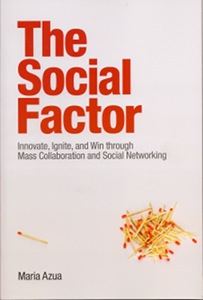
The Social Factor book cover
Maria Azua, an IBM executive, outlines the benefits of social media for business in The Social Factor Innovate, Ignite, and Win Through Mass Collaboration and Social Networking (IBM Press, $29.99), a 248-page paperback book published in 2010. Her goal in writing the book was to provide strategic and tactical insights for business executives based on her and her colleagues’ experience and case studies within her company, and help readers avoid social networking mistakes.
To complete the project which took four years of hands on investigation and analysis she relied on the contribution and input of 10 colleagues: Boas Betzler, Bill Bodin, Christopher Douglass, Brian Goodman, Reed Mullen, Carl Burnett, Dave Newbold, Mahesh Parakdar, Gina Poole, Michael Roche, and Laurisa Rodriguez, the only contributor that was not from IBM.
She and her colleagues at IBM believe three forces are driving social and workplace interactions: Information overload from the Information Age, standardization of technology, and the availability of low cost two-way communication online.
The book is divided into 12 chapters: Dawn of the Social Age, Social Age Organizations, Wikis: Bringing the Crowds to You, Blogs: Your Personal News Outlet, Tagging and Social Clouds, Cloud Computing Paradigm, Social Media and Culture, On the Shoulders of Giants, Social Brain and the Ideation Process, Social Innovation, Social Economy, and Mobile Society.
Maria Azua, vice president of Cloud Computing Enablement, IBM Enterprise Initiatives, is responsible for the technical implementation, deployment and operations of the Common Cloud Platform Living Lab share service, as well as the IBM Smart Business Development and Test on the IBM Cloud. She is also responsible for the creation of a community of independent software vendors, business partners, and technical community that fosters cloud computing IT methodologies and applications.

Click here to buy The Social Factor
Comments:
Filed Under: Books
Posted by Elena del Valle on January 20, 2010
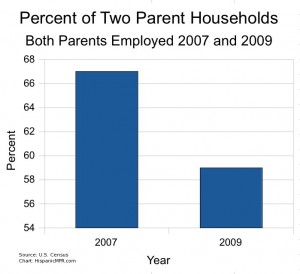
Click on image to enlarge
Between 2007 and 2009 unemployment for couples with children under 18 years of age doubled, according to the United States Census Bureau. Two parent families were more affected than single parent families and Hispanic and black families were also more affected than non Hispanic white families, according to the March 2009 Current Population Survey. While in 2007 in 67 percent of households with a married couple both parents worked by 2009 only 59 percent of those households had both parents working.
In homes with married couples and children 6 percent of husbands and 4 percent of wives were unemployed last year compared to 3 percent of husbands and 2 percent of wives two years earlier. Children living with two parents varied greatly by ethnicity with Asian children being the most likely to live in a dual parent home, 85 percent. Among non Hispanic whites 78 percent of children lived with both parents while 69 percent of Hispanics and 38 percent of blacks shared that type of home.
At the same time, the number of interracial and mixed ethnicity marriages increased. Last year, in 7.6 percent of couples the husband and wife were of different races or a Hispanic was married to a non Hispanic. In 2003, the percent of such marriages was 6.4.
“Segmentation by Level of Acculturation” audio recording

Presenter Miguel Gomez Winebrenner
Discusses
- Assimilation versus acculturation
- Factors that affect Latino acculturation
- How to know if someone is acculturated
- Number of years necessary for acculturation
- Effects of immigration debate on acculturation
- Three main ways of segmenting Latinos
Click here for details about “Segmentation by Level of Acculturation”
Posted by Elena del Valle on January 18, 2010

Author Steve Bersman
Photo: Steve Bergsman
A podcast interview with Steve Bergsman, author, After The Fall: Opportunities and Strategies for Real Estate Investing in the Coming Decade is available in the Podcast Section of Hispanic Marketing & Public Relations, HispanicMPR.com. During the podcast, Steve discusses the recovery of the real estate market in the United States with Elena del Valle, host of the HispanicMPR.com podcast.
For more than twenty-five years, Steve has written about finance and real estate, contributing to a wide range of magazines, newspapers and wire services, including The New York Times, The Wall Street Journal Sunday, Global Finance, Executive Decision, Chief Executive, The Australian, Investment Dealer’s Digest, Reuters News Service and Copley News Service. He has been a regular contributor to the Ground Floor real estate column in Barron’s and has written for the leading real estate industry publications such as National Real Estate Investor, Institutional Real Estate Letter, Retail Traffic, Multifamily Trends, Real Estate Portfolio, Shopping Center World, Mortgage Banking and Urban Land.
In addition to After The Fall published in 2009, he authored several other books including Maverick Real Estate Investing: The Art of Buying and Selling Properties Like Trump, Zell, Simon and World’s Greatest Land Owners; Maverick Real Estate Financing: The Art of Raising Capital and Owning Properties Like Ross, Sanders, and Carey; and Passport to Exotic Real Estate: Buying U.S. and Foreign Property in Breathtaking, Beautiful and Faraway Lands.
To listen to the interview, scroll down until you see “Podcast” on the right hand side, then select “HMPR Steve Bergsman” click on the play button below or download the MP3 file to your iPod or MP3 player to listen on the go, in your car or at home. To download it, click on the arrow of the recording you wish to copy and save it to disk. The podcast will remain listed in the January 2010 section of the podcast archive.
Click here to buy After the Fall: Opportunities and Strategies for Real Estate Investing in the Coming Decade
Posted by Elena del Valle on January 15, 2010
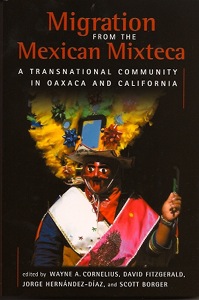
Migration from the Mexican Mixteca A Transnational Community in Oaxaca and California (Center for Comparative Immigration Studies, $29) is a 268-page paperback book about migrant communities in Mexico’s Mixteca region of Oaxaca and San Diego in California. Twenty women and twelve men contributed eight chapters to the book. Edited by Wayne A. Cornelius, David Fitzgerald, Jorge Hernández Díaz, and Scott Borger the book is based on surveys and interviews with migrant workers and potential migrants conducted by a team in both countries in 2007 and 2008.
The editors strive to show how some Oaxaca-based and California-based natives of the town of San Miguel Tlacotepec have built parallel communities in spite of the international divide. They examine the efficacy and impact of border enforcement, how undocumented status affects health and education, and how modern telecommunications are providing the tools for transborder migrant networks.
The eight chapters are: San Miguel Tlacotepec as a Community of Emigration; Strategies for Success: Border Crossing in an Era of Heightened Security; Setting Down Roots: Tlacotepense Settlement in the United States; Long-Distance Lives: International Migrant Networks and Technology in the United States and Mexico; Going to School, Going to El Norte: Migration’s Impact on Tlacotepense Education; Lucharle por la Vida: The Impact of Migration on Health; Between Here and There: Ethnicity, Civic Participation, and Migration in San Miguel Tlacotepec; and The Economics of Migration: Agriculture, Remittances and Investment.

Wayne A. Cornelius, director emeritus, Center for Comparative Immigration Studies (CCIS)
Cornelius is director emeritus, Center for Comparative Immigration Studies (CCIS), University of California-San Diego as well as Distinguished Professor of Political Science and Theodore E. Gildred Chair in U.S.-Mexican Relations at that university. Fitzgerald, associated director, CCIS is author of A Nation of Emigrants: How Mexico Manages Its Migration. Borger is a Ph.D. candidate in economics at the University of California, San Diego. Hernandez-Diaz is professor of anthropology at the Universidad Autonoma Benito Juarez de Oaxaca.
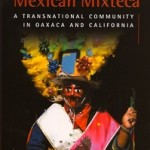
Click here to buy Migration from the Mexican Mixteca
Comments:
Filed Under: Books
Posted by Elena del Valle on January 13, 2010
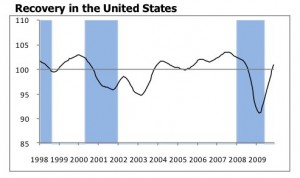
Click on image to enlarge
Graphic: Organization for Economic Co-operation and Development (OECD)
With an additional 85,000 jobs lost in the United States last month there is no doubt that joblessness has become the leading and most serious indicator of our nation’s economic crisis. According to a recent The New York Times article, as of December 2009 most unemployed Americans remain in that state for 29 weeks, the longest since the government began tracking that data in 1948. In order just to keep pace with new arrivals into the workforce the country needs 100,000 new jobs a month. There simply are not enough jobs. Worst of all there is no prospect of enough new jobs developing anytime soon. Are things getting better elsewhere?
At the end of last week the Organization for Economic Co-operation and Development (OECD) which tracks changes in 29 countries announced its composite leading indicators or CLIs for November 2009 point to “stronger signals for recovery than last month’s assessment.” Researchers calculated CLIs for 29 OECD countries and 9 zones.
Analysts at the Paris-based organization interpret the new data to indicate an upward movement in the index of industrial production for the seven countries they examined, except Canada and the United Kingdom. The release also indicates that the CLIs for those major seven countries (Canada, France, Germany, Italy, Japan, United Kingdom and United States) moved above their long-term trend, indicating “an expansionary outlook relative to trend.” The organization’s data for major non member countries economies points to a recovery.
Specifically, the CLI for the OECD area increased by 1.0 point in November 2009 and was 8.2 points higher than in November 2008. The CLI for the United States increased by 1.0 point in November, 6.8 points higher than a year earlier. The Euro area’s CLI increased by 1.1 point in November, 10.9 points higher than a year ago. The CLI for Japan increased by 1.2 point in November, 5.4 points higher than a year ago.
The CLI for the United Kingdom increased by 1.2 point in November 2009, 10.7 points higher than a year ago. The CLI for Canada increased by 1.0 point in November, 9.4 points higher than a year ago. The CLI for France increased by 1.2 point in November, 11.9 points higher than a year ago. The CLI for Germany increased by 1.4 points in November, 12.3 points higher than a year ago. The CLI for Italy increased by 0.9 point in November, 13.8 points higher than a year ago.
The CLI for China increased 0.2 point in November 2009, 7.6 points higher than a year ago. The CLI for India is remained the same in November and 4.3 points higher than a year ago. The CLI for Russia increased by 1.0 point in November, 3.4 points higher than a year ago. The CLI for Brazil increased by 0.8 point in November, 1.3 points lower than a year ago.
What these numbers mean to everyday people in practical terms is anyone’s guess. For now, it seems to offer a small glimmer of hope that the famous V shape of the economic trend is moving up and away from the bottom in some countries.
OECD provides a forum for member governments to compare policy experiences, “seek answers to common problems, identify good practice and coordinate domestic and international policies.” The OECD-Total covers 29 countries: Australia, Austria, Belgium, Canada, Czech Republic, Denmark, Finland, France, Germany, Greece, Hungary, Ireland, Italy, Japan, Korea, Luxembourg, Mexico, Netherlands, New Zealand, Norway, Poland, Portugal, Slovak Republic, Spain, Sweden, Switzerland, Turkey, United Kingdom, and United States. The Euro area (only Euro area countries that are members of OECD) covers 13 countries: Austria, Belgium, Finland, France, Germany, Greece, Italy, Ireland, Luxembourg, the Netherlands, Portugal, Slovak Republic and Spain. The Major Five Asia area covers China, India, Indonesia, Japan and Korea.
Posted by Elena del Valle on January 11, 2010

Chocolate brownie, dark chocolate tablets and cocoa powder
Photos: Simon & Baker, National Confectioners Association
When I think of chocolate my mouth waters. I, like millions of people around the world, especially in the West, think this derivative of the cocoa bean delicious. It is interesting to note that western nations seem to be the most fond of chocolate. While 85 percent of cocoa is imported from West Africa 70 percent of the profit from chocolate sales is made in western countries; and 80 percent of the chocolate market is controlled by only six companies such as Nestle, Mars and Cadbury, according to the World Atlas of Chocolate website.
Could weather play a role? According to Chocolate.org, chocolate is consumed by more people in the winter than in other seasons. This might explain why 16 of the top 20 chocolate consumers are European; they are said to eat 40 percent of the chocolate produced. In the United States, sales of chocolates are more or less even nationally with the exception of the southern states in summer where sales drop slightly. Peak chocolate periods, as might be expected, are Valentine’s Day, Christmas, Halloween and Easter.
In 2009, in spite of the economic hardships faced by so many people across international boundaries, chocolate sales increased. Perhaps not unexpectedly chocolate candy sales in China and the Ukraine rose 18 percent and 12 percent, respectively. Both countries have exhibited steady sales increases since 2005 and some market researchers believe the growth will continue through 2013.
“It’s clear that despite economic trouble this year, the world’s chocolate lovers didn’t deviate from their favorite treat. Chocolate is a small, affordable indulgence for shoppers who are cutting back on spending elsewhere. Even in countries not known for chocolate consumption, sales are on the rise,” said Marcia Mogelonsky, global food and drink analyst at Mintel, an international supplier of consumer, product and media intelligence.

Chocolate truffles
Last year, in Great Britain chocolate sales grew 5.9 percent while in the United States there was an increase of 2.6 percent in chocolate sales compared to 2008. Chocolate sales in Argentina rose 1.8 percent from the previous year; and sales of the brown treats went up 3.2 percent in Belgium. The sales increase in the United States may be the result of inflation, population growth, and new product development, according to Susan Whiteside, spokesperson for the National Confectioners Association, a trade organization dedicated to “advancing and promoting the interests of the confectionery industry and its consumers.”
“We agree with the Mintel findings that chocolate sales in the United States increased (last year). Sales for the period ending November 1 (2009) increased 2.8 percent while unit sales dropped slightly,” said Whiteside, who explained by phone that a 1 to 3 percent annual total revenue increase is normal in this market regardless of what may be happening in the economy.
Perhaps people concerned, depressed, anxious or just waiting to see how and when international economic woes will settle down are turning to chocolate for solace. To take advantage of the trend chocolate makers offered the same or a greater number of chocolate products in 2009 compared to 2008. According to the Mintel Global New Products Database (GNPD), in Latin America, Asia, the Middle East and Africa, companies released more new products than they did in 2008.
Swiss shoppers spend the most for chocolate per person per year, spending the equivalent of $206. Belgians and Brits spend $90 and $106. Consumption of chocolate in the Americas is more moderate with individuals in the United States spending $55 each, and Argentinians buying an average of $35 per year of chocolate candy.
While revenue from chocolate sales in the United States increased the actual number of chocolate products sold decreased (the difference was made up by an increase in the price of chocolates), according to Whiteside. Perhaps because of the price increases representatives from United States chocolate makers Hershey’s (who also make Cadbury in the United States), Nestle’s and Ghirardelli did not reply to email and telephone request for comment.
According to a July 2008 Mintel survey, 78 percent of respondents to a United States survey buy chocolate for themselves and 47 percent bought the sweet treat for others in the past year. The most common reason (two thirds of respondents) they gave for purchasing chocolate was because they had a craving. Two thirds of respondents bought dark chocolate, half bought premium brand chocolate, 16 percent bought sugar-free and 13 percent purchased organic chocolate.
In recent years Americans have been purchasing an ever growing number of premium chocolate products from brands like Ghirardelli, Ferraro and Lindt. In the United States, consumers prefer milk chocolate but their preference for dark chocolate is increasing. This change in the market might be explained by the aging adult population’s preference for stronger flavors, according to Whitewise.
Target Latinos effectively by understanding how they shop
“Hispanic Holiday Shopping Patterns” audio recording

Manuel Delgado, CEO Agua Marketing, gives a presentation and participates in an extended Q&A discussion about
- Hispanic shopping patterns national survey
- Why Latino consumers may be more desirable than general market shoppers
- Hispanics holiday shopping patterns and behaviors
Click here for information on “Hispanic Holiday Shopping Patterns” audio recording
Posted by Elena del Valle on January 8, 2010

Alice in Alice in Wonderland

The Red Queen
Photos, video: Disney Enterprises, Inc.
With the exception of Edward Scissorhands and Bettle Juice, I’m not much of a Tim Burton (film director) fan. His dark quirky style makes me want to run away from the theater. And Alice in Wonderland is a bit of an acquired taste. Having said that, Disney’s soon to be released Alice in Wonderland in 3D looks colorful and intriguing in the trailers (no screener was available). It makes me think of Cirque du Soleil. Scroll down to watch a trailer.

A scene from Alice in Wonderland
The cast includes familiar faces like Johnny Depp as the Mad Hatter, Anne Hathaway, Helena Bonham Carter as The Red Queen, Crispin Glover, Matt Lucas, Marton Csokas, Tim Pigott-Smith, Lindsay Duncan, Geraldine James, Leo Bill, Jemma Powell, Mairi Ella Challen and Mia Wasikowska as Alice.
Linda Woolverton based her screenplay on the Lewis Carroll classics Alice’s Adventures in Wonderland and Through the Looking-Glass. In the modern day tale, a 19-year-old Alice returns to the fantasy world she first encountered as a young girl to find her childhood friends, the White Rabbit, Tweedledee and Tweedledum, the Dormouse, the Caterpillar, the Cheshire Cat and Johnny Depp’s Mad Hatter.




























